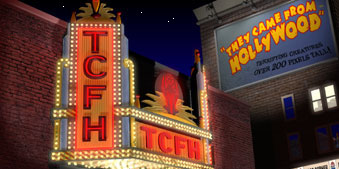
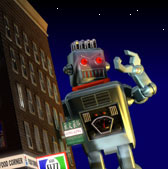

You may have seen Ray Harryhausen credited with Technical Effects (meaning special effects) for his amazing stop-motion animation in movies like Mighty Joe Young, It Came From Beneath The Sea, and The Beast From 20,000 Fathoms. Well, this column isn't really about special effects, just technical game details and behind-the-scenes programming stuff that we thought you might find interesting. We'll be updating it regularly, or whenever Lars thinks of something.
03/01/03: MEET CLARA
THEREMIN PROJECT X
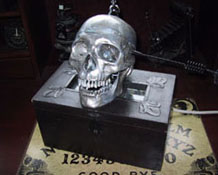
Leon Theremin (born Lev Sergeivitch Termen) invented the theremin around 1919. In the late 1920s, he toured Europe with this new instrument, ending in the US, where he met Clara Rockmore, a gifted violinist who became the world's most famous thereminist (and whom we named our theremin after). The theremin, with its haunting and eerie sound, was often used in science fiction and horror movie soundtracks during the 1950s and '60s.
The theremin uses changes in capacitance caused by the proximity of the human body to control pitch and often volume -- you wave your hand over the theremin's antennae, and it makes a sound. The distinctive sound partly comes from the way it smoothly transitions from note to note, like a trombone, violin, or fretless guitar. Because of that smooth range of pitch, it requires the player to have perfect pitch to find the notes. And unlike most instruments, the player has no actual physical contact with the instrument, so the player cannot rely on "touch memory" to find the notes. Also, because of the delicate tuning required, the notes may not always be in the exact same place spatially from session to session. This make it a difficult instrument to play accurately, although anyone can make fun noises with one.
Theremins are delicate devices -- most require careful tuning...they have to be so sensitive to properly detect and respond evenly and smoothly to the very slight changes in capacitance caused by the human body's presence. Things like temperature changes, distance of the player's body, or any nearby metal or other capacitance-affecting object can all make a theremin fall out of tune. The playing style of a theremin often includes a strong vibrato, which also helps in finding the note's pitch and blending the note to note transitions. This is done by gently waving the player's hand or fingers as it is moved around the pitch antenna. Some theremins also have a volume control antenna, which is usually mounted at a 90' angle from the pitch control antenna and played with the left (or less dominant) hand.
PARTS IS PARTS
The early theremins were made using radio tubes, but ours - like most modern ones - is solid state. I built a couple theremins while experimenting, but I wasn't thrilled with their performance -- too unstable, an unsatisfying basic tone, too simple, or just plain didn't work. :) So I decided for this one I would get a proven design, and ordered the Theremax kit from PAIA. This kit includes several options like a volume control aerial, outputs of the controllers as a voltage control (for controlling other devices). Its tone is also closer to that classic theremin sound.
We have a lot of skulls lying around the house (don't worry - they're model skulls. Okay, maybe just worry less), and thought it might be interesting to make a skull theremin. The idea of a skull with antennae going "OOooooooooOOOOO" was just too good to ignore.
To house the components, we used a simple wooden box with a hinged lid. The circuit board, power supply, etc. were mounted inside, and we cut out the back and put in clear plexiglass to mount the panel, jacks and knobs. On top we attached a model skull -- the antennae are attached to the top and side of the skull. We used car antennas, as the spring makes for a regular decaying LFO (low-frequency oscillation) effect when "thwapped". The box has a couple small glass windows in the top, and a red light inside makes the skull from underneath. A pair of large red LEDs in the eyesockets will complete the effect, uh, when we get around to it.
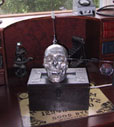
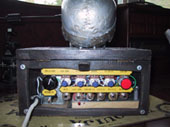
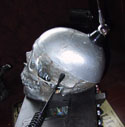
LINKS
 | © 2004 Octopus Motor They Came From Hollywood is a registered trademark of Octopus Motor |  |